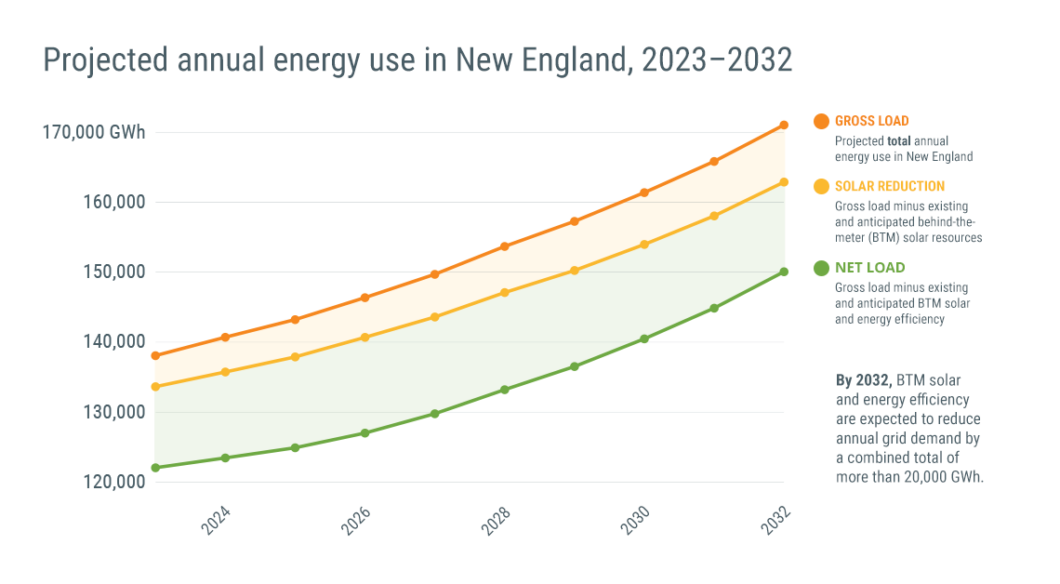Next decade will see steady increase in New England’s electricity use, 2023 CELT Report predicts

ISO New England projects demand on the region’s power grid will increase by about 23% over the next decade due to accelerating electrification of the heating and transportation sectors. The findings were published in the 2023–2032 Forecast Report of Capacity, Energy, Loads, and Transmission (CELT Report), a primary source for assumptions used in the ISO’s system planning and reliability studies.
The CELT Report provides a snapshot of the New England power system, including:
- A long-term forecast for energy consumption and peak demand, including 10-year forecasts accounting for the impacts of energy efficiency (EE) and behind-the-meter (BTM) solar generation
- The potential output of resources with capacity supply obligations, as well as the total generating capability of resources in the region
- A breakdown of the region’s generators by fuel/unit classification
- A link to the listing of transmission projects proposed, planned, and under construction
New England electricity projections for 2023 to 2032
The ISO develops the gross long-term forecast for electricity demand using state and regional economic forecasts, years of weather history in New England, and forecasts for energy demand to power electric vehicles (EVs), air-source heat pumps (ASHPs), and other electric heating technologies. This year’s heating electrification forecast is the first to include projections for the commercial sector as well as residential water heating, and refines residential space heating forecast models.
Results of the ISO’s EE forecast and solar photovoltaic (PV) forecast are applied to the gross forecast to develop a net long-term forecast. Since EE and PV reduce the amount of electricity consumers draw from the bulk power system, the net forecast represents actual grid demand.
Overall electricity use in New England
| Total Annual Use (GWh) | 2023 | 2032 |
| Gross Forecast | 138,081 | 171,050 |
| Net Forecast | 122,057 | 150,073 |
- Gross annual electricity use is expected to grow by 2.4% annually over the 10-year period, while net annual use is expected to grow by 2.3% annually.
- EE is projected to reduce grid demand by 11,582 GWh this year and 12,810 GWh in 2032.
- BTM PV is projected to reduce grid demand by 4,442 GWh this year, rising to 8,168 GWh in 2032.
- EVs are expected to account for 13,961 GWh of grid demand in 2032, while heating electrification is expected to account for 7,334 GWh of demand that year.

Summer peak demand, average weather
Peak demand is a measure of the highest amount of electricity used in a single hour. The expected peak for each year of the forecast occurs during the summer. Average weather is used to develop what is known as the 50/50 forecast, meaning there is a 50% chance that peak demand will be above or below the forecast.
| Peak Demand (MW) | 2023 | 2032 |
| Gross Forecast | 27,556 | 30,559 |
| Net Forecast | 24,605 | 27,046 |
- Under typical summer weather conditions, gross peak demand is expected to rise annually at a rate of 1.2%. Net peak demand is expected to rise at an annual rate of 1.1%. For weather that is hotter than average, the gross peak is expected to rise 1.1% annually and the net peak 1.0%.
- The net forecast includes summer peak demand reductions from BTM PV of 981 MW this year, rising to 1,117 MW in summer 2032.
- EE is expected to reduce summer peak demand by 1,969 MW this year, and by 2,436 MW in 2032.
- Transportation electrification is expected to contribute 2,346 MW to summer peak demand in 2032.
Summer peak demand, hotter-than-average weather
The 90/10 forecast—which reflects above-average heat and humidity in the summer, and colder-than-average temperatures in the winter—means there is a 10% chance that peak demand will be higher than the forecast.
| Peak Demand (MW) | 2023 | 2032 |
| Gross Forecast | 29,372 | 32,526 |
| Net Forecast | 26,421 | 28,974 |
Winter peak demand, average weather
| Peak Demand (MW) | Winter 2023–2024 | Winter 2032–2033 |
| Gross Forecast | 22,053 | 28,810 |
| Net Forecast | 20,269 | 26,267 |
- Under the 50/50 forecast, winter gross peak demand is expected to rise by an average of 3.0% annually through the winter of 2032–2033, while net peak demand is expected to rise by 2.9% annually. For weather that is colder than average, the gross and net peaks are both expected to increase by 3.3% annually.
- Transportation electrification is forecast to contribute 3,420 MW to the winter peak in 2032–2033.
- Heating electrification is projected to contribute 2,965 MW to the winter peak under average weather in 2032–2033.
- BTM PV does not reduce winter peak demand, because the peak typically occurs after sunset.
Winter peak demand, colder-than-average weather
| Peak Demand (MW) | Winter 2023–2024 | Winter 2032–2033 |
| Gross Forecast | 22,816 | 30,611 |
| Net Forecast | 21,032 | 28,068 |
- Heating electrification is projected to contribute 4,033 MW to the winter peak under colder-than-average weather in 2032–2033.
- Categories
- Publications
- Tags
- electrification, energy efficiency, forecast, solar
